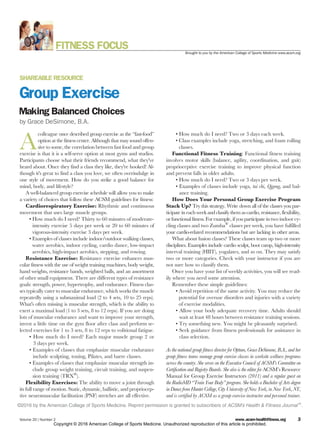More Related Content
Similar to Making Balanced Choices in Group Exercise Classes
Similar to Making Balanced Choices in Group Exercise Classes (20)
Making Balanced Choices in Group Exercise Classes
- 1. SHAREABLE RESOURCE
Group Exercise
Making Balanced Choices
by Grace DeSimone, B.A.
A
colleague once described group exercise as the “fast-food”
option at the fitness center. Although that may sound offen-
sive to some, the correlation between fast food and group
exercise is that it is a self-serve option at most gyms and studios.
Participants choose what their friends recommend, what they've
heard about. Once they find a class they like, they're hooked! Al-
though it's great to find a class you love, we often overindulge in
one style of movement. How do you strike a good balance for
mind, body, and lifestyle?
A well-balanced group exercise schedule will allow you to make
a variety of choices that follow these ACSM guidelines for fitness:
Cardiorespiratory Exercise: Rhythmic and continuous
movement that uses large muscle groups.
• How much do I need? Thirty to 60 minutes of moderate-
intensity exercise 5 days per week or 20 to 60 minutes of
vigorous-intensity exercise 3 days per week.
• Examples of classes include indoor/outdoor walking classes,
water aerobics, indoor cycling, cardio dance, low-impact
aerobics, high-impact aerobics, stepping, and rowing.
Resistance Exercise: Resistance exercise enhances mus-
cular fitness with the use of weight training machines, body weight,
hand weights, resistance bands, weighted balls, and an assortment
of other small equipment. There are different types of resistance
goals: strength, power, hypertrophy, and endurance. Fitness clas-
ses typically cater to muscular endurance, which works the muscle
repeatedly using a submaximal load (2 to 4 sets, 10 to 25 reps).
What's often missing is muscular strength, which is the ability to
exert a maximal load (1 to 3 sets, 8 to 12 reps). If you are doing
lots of muscular endurance and want to improve your strength,
invest a little time on the gym floor after class and perform se-
lected exercises for 1 to 3 sets, 8 to 12 reps to volitional fatigue.
• How much do I need? Each major muscle group 2 or
3 days per week.
• Examples of classes that emphasize muscular endurance
include sculpting, toning, Pilates, and barre classes.
• Examples of classes that emphasize muscular strength in-
clude group weight training, circuit training, and suspen-
sion training (TRX®
).
Flexibility Exercises: The ability to move a joint through
its full range of motion. Static, dynamic, ballistic, and propriocep-
tive neuromuscular facilitation (PNF) stretches are all effective.
• How much do I need? Two or 3 days each week.
• Class examples include yoga, stretching, and foam rolling
classes.
Functional Fitness Training: Functional fitness training
involves motor skills (balance, agility, coordination, and gait)
proprioceptive exercise training to improve physical function
and prevent falls in older adults.
• How much do I need? Two or 3 days per week.
• Examples of classes include yoga, tai chi, Qigong, and bal-
ance training.
How Does Your Personal Group Exercise Program
Stack Up? Try this strategy. Write down all of the classes you par-
ticipate in each week and classify them as cardio, resistance, flexibility,
orfunctionalfitness.Forexample,if you participateintwo indoor cy-
cling classes and two Zumba®
classes per week, you have fulfilled
your cardio-related recommendations but are lacking in other areas.
What about fusion classes? These classes team up two or more
disciplines. Examples include cardio sculpt, boot camp, high-intensity
interval training (HIIT), yogalates, and so on. They may satisfy
two or more categories. Check with your instructor if you are
not sure how to classify them.
Once you have your list of weekly activities, you will see read-
ily where you need some attention.
Remember these simple guidelines:
• Avoid repetition of the same activity. You may reduce the
potential for overuse disorders and injuries with a variety
of exercise modalities.
• Allow your body adequate recovery time. Adults should
wait at least 48 hours between resistance training sessions.
• Try something new. You might be pleasantly surprised.
• Seek guidance from fitness professionals for assistance in
class selection.
As the national group fitness director for Optum, Grace DeSimone, B.A., and her
group fitness teams manage group exercise classes in worksite wellness programs
across the country. She serves on the Executive Council of ACSM's Committee on
Certification and Registry Boards. She also is the editor for ACSM’s Resource
Manual for Group Exercise Instructors (2011) and a regular guest on
the RadioMD “Train Your Body” program. She holds a Bachelor of Arts degree
in Dance from Hunter College, City University of New York, in New York, NY,
and is certified by ACSM as a group exercise instructor and personal trainer.
©2016 by the American College of Sports Medicine. Reprint permission is granted to subscribers of ACSM’s Health & Fitness JournalW
.
FITNESS FOCUS Brought to you by the American College of Sports Medicine www.acsm.org
Volume 20 | Number 2 www.acsm-healthfitness.org 3
Copyright © 2016 American College of Sports Medicine. Unauthorized reproduction of this article is prohibited.
